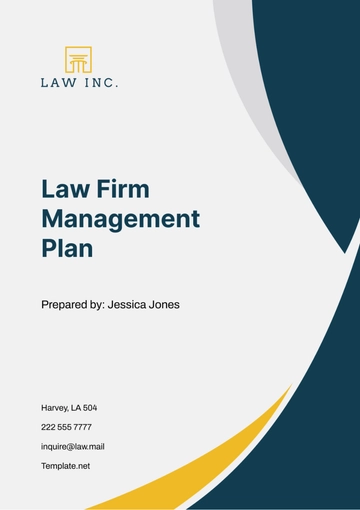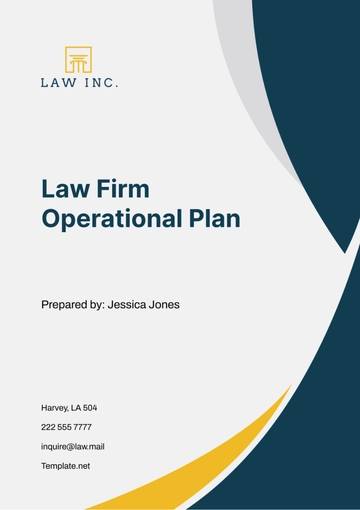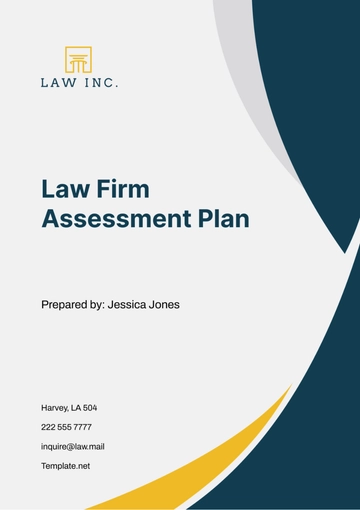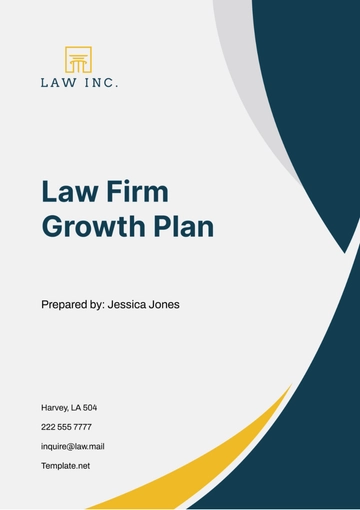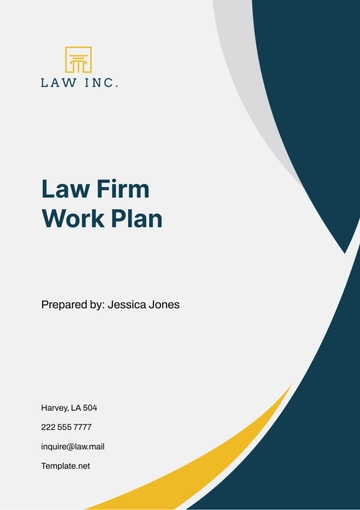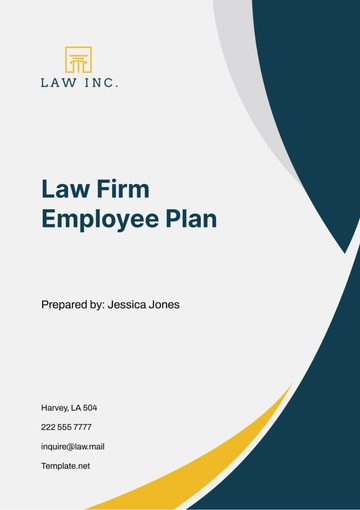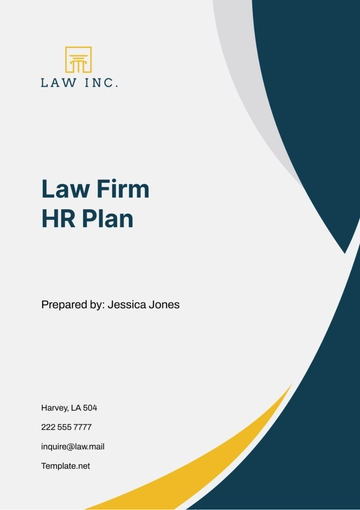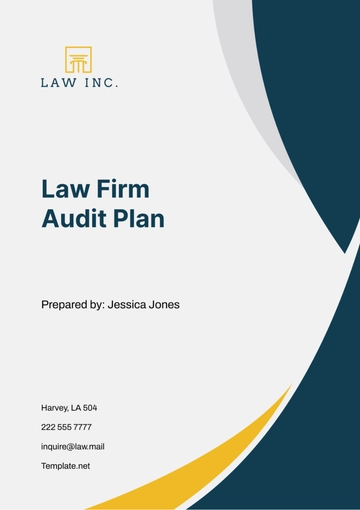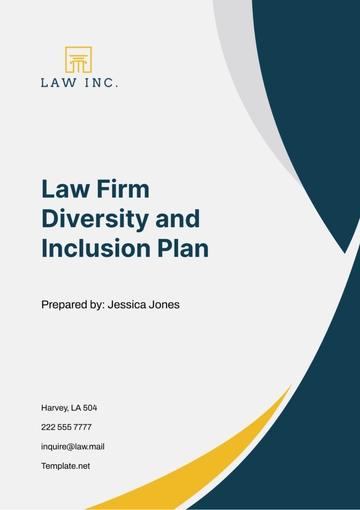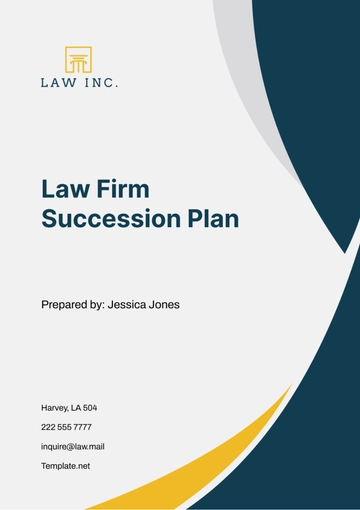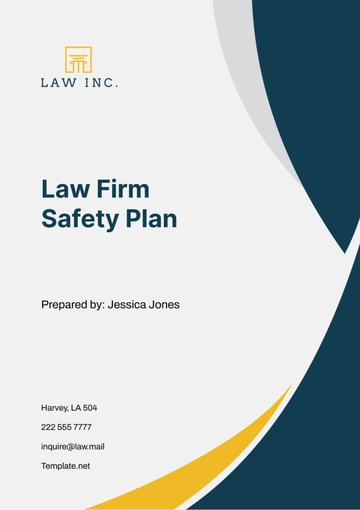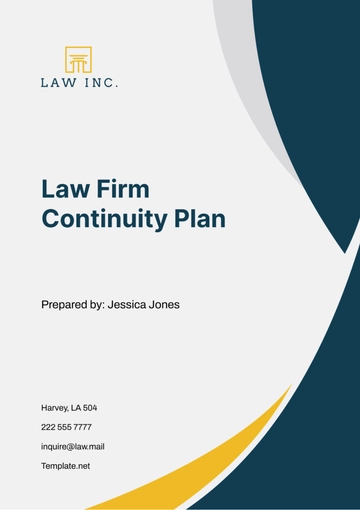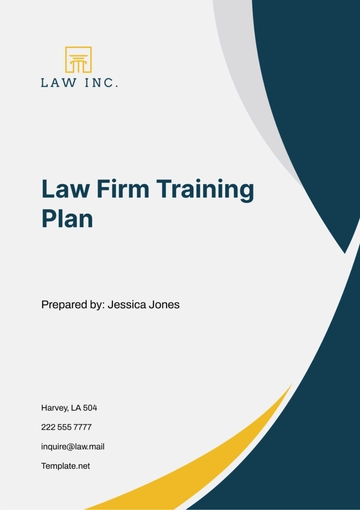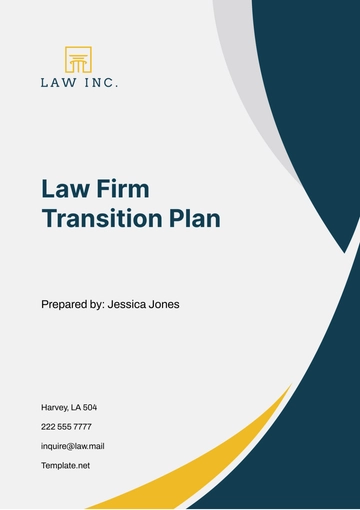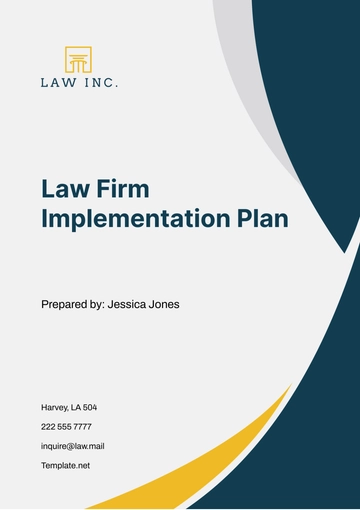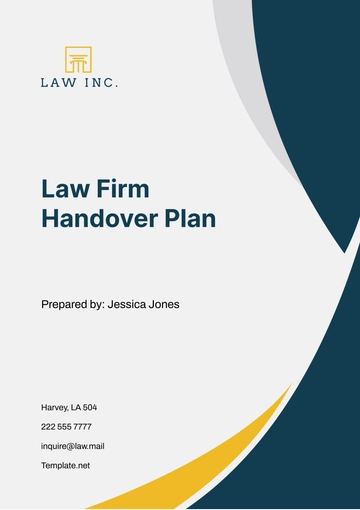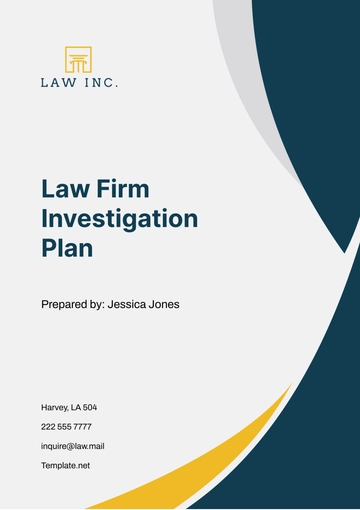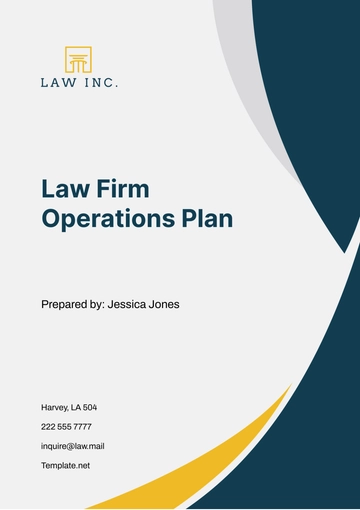Free Law Firm Assessment Plan
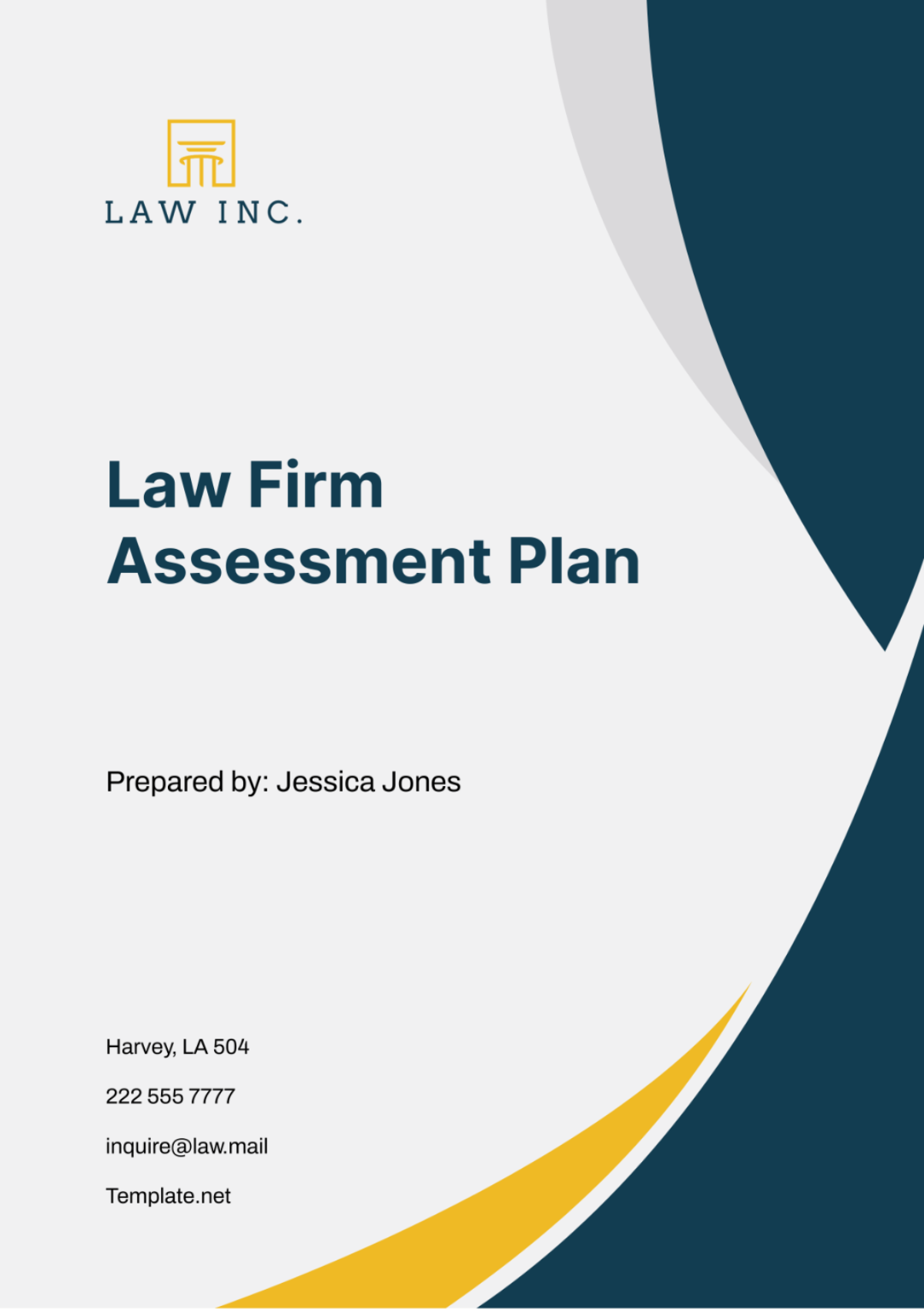
1. Introduction
Purpose of the Assessment
The primary purpose of this assessment is to evaluate the operational efficiency, legal compliance, financial stability, and client satisfaction at [Your Company Name]. This will help in identifying areas for improvement, potential risks, and opportunities for growth.
Objectives and Goals
To ensure all practices comply with the latest legal standards.
To enhance the firm's market competitiveness.
To improve client satisfaction and retention rates.
To identify opportunities for cost reduction and increased profitability.
Scope of the Assessment
The assessment will cover all key areas of the firm’s operations, including governance, financial management, client management, human resources, technology, and marketing.
2. Firm Overview
History and Background
[Your Company Name] was founded in [Year] and has grown to become one of the leading mid-size law firms specializing in corporate law and civil litigation. The firm has expanded its practice areas over the years to include intellectual property and environmental law, serving clients nationwide.
Organizational Structure
Senior Partners: 5
Associates: 20
Paralegal Staff: 15
Administrative Staff: 10
Marketing and Business Development Team: 5
Key Practice Areas
Corporate Law
Civil Litigation
Intellectual Property
Environmental Law
3. Governance and Leadership Assessment
Leadership Roles and Responsibilities
At [Your Company Name], our governance structure is meticulously structured and is primarily developed based on a partnership model. This essentially means that the responsibility for making strategic decisions falls under the purview of a carefully selected board that predominantly consists of our most senior partners. Their integral role does not just stop at decision-making, they guide the firm through an ever-evolving market landscape and strive hard to maintain and uphold the highest ethical standards. The effectiveness and efficiency of our leadership are critically appraised through their strategic abilities, adaptability, and versatility in navigating market changes, and their steadfast commitment to upholding the integrity and ethical standards of the company.
Board and Management Effectiveness
A review, which is conducted twice a year or bi-annually, is designed to assess and scrutinize the overall performance of the board and management. The key elements or performance indicators that this bi-annual review focuses on include the level of efficiency in strategic decision-making, the ability to provide financial oversight, and the adherence to the principles of ethical governance. These indicators are crucial to understanding whether or not the board and management are performing at an optimal level.
Succession Planning and Leadership Development
The firm has recognized the necessity for an approach to succession planning that is more structured and systematic. At present, the energies of the corporation are geared towards the identification and cultivation of potentially skilled individuals from within the organization itself. This internal focus aims to guarantee the seamless transition of leadership roles, thereby ensuring the continuity of leadership.
4. Legal Compliance and Risk Management
Compliance with Laws
Federal: Compliance with the Sarbanes-Oxley Act, Americans with Disabilities Act, etc.
State: Adherence to local business operation laws and professional licensing requirements.
Local: Compliance with local employment laws and municipal regulations.
Internal Controls and Audit Mechanisms
The performance of annual audits is an important procedure that is carried out with the primary intention of assessing just how effective internal controls are. The areas of focus during these audits usually include the examination of financial transactions carried out within the organization and the measures put in place to ensure the protection of client data.
Data Protection and Privacy Policies
The firm is strictly committed to adhering to data protection policies that are stringent in nature. This includes compliance with the General Data Protection Regulation (GDPR) along with other data protection regulations that are relevant and applicable.
Conflict of Interest Policies
In order to effectively manage and mitigate any potential conflicts that may arise, a comprehensive conflict of interest policy has been established and implemented. This thorough policy ensures that every engagement with clients is handled ethically and responsibly, further reinforcing the importance of maintaining transparency and fairness in all dealings.
5. Financial Performance and Management
Revenue, Profitability, and Financial Health Analysis
Year | Total Revenue | Operating Costs | Net Profit | Profit Margin |
|---|---|---|---|---|
[Year] | $10M | $6M | $4M | 40% |
[Year] | $12M | $7M | $5M | 41.7% |
Billing Practices and Accounts Receivable Management
The organization in question utilizes a hybrid billing model. This model skillfully merges two types of charge systems i.e., hourly rates, where charges are based on the time spent on a task, and fixed fees, where an agreed-upon, unchanging amount is charged. Moreover, the firm conducts an annual review of its billing practices. The purpose of this yearly assessment is to guarantee that their billing practices are not only staying abreast with the industry standards but also meet and possibly, exceed the expectations of their clients. The alignment of billing practices with industry standards and client expectations is crucial to maintaining a transparent and trusted relationship with the customers.
Budgeting, Financial Planning, and Investment Strategies
A financial plan with a trajectory of five years is formulated, with revisions and updates done each year. The focal point of this plan is making investments in three key areas - technology, human resources, and marketing, with the underlying objective of driving growth in the future.
6. Client Management and Satisfaction
Client Intake Processes and Client Management Systems
The client intake process at [Your Company Name] is streamlined through a sophisticated client management system that ensures quick and efficient handling of new client information, conflict checks, and initial consultations. The system integrates seamlessly with the firm’s CRM to maintain up-to-date client records and track all engagements.
Client Feedback and Satisfaction Surveys
Survey Methodology: Clients are surveyed annually using a combination of online surveys and telephone interviews to gather comprehensive feedback on the firm's performance.
Key Areas of Feedback: Service quality, responsiveness, outcome satisfaction, and willingness to recommend the firm to others.
Recent Improvements: Based on last year's feedback, the firm has improved its client communication protocols, reducing response times by 30%.
Client Retention Rates and Strategies
Retention Initiatives: Personalized follow-ups, regular updates on legal developments relevant to clients' interests, and loyalty discounts.
Impact: These strategies have contributed to an 85% retention rate, well above the industry average.
Future Plans: Implement a client advisory board to involve key clients in the development of service offerings and firm policies.
7. Human Resources Management
Staff Recruitment, Retention, and Turnover Rates
Year | New Hires | Departures | Net Growth | Turnover Rate |
|---|---|---|---|---|
[Year] | 5 | 3 | 2 | 10% |
[Year] | 7 | 2 | 5 | 6.7% |
Training and Professional Development Programs
At [Your Company Name], we place a large emphasis on the importance of ongoing growth and professional development for all members of our team. We believe in the crucial role that in-depth knowledge of modern legal practices and new technologies plays in maintaining our competencies and competitiveness in the legal sector. Therefore, we invest exhaustively in a combination of continuous learning and development initiatives. These opportunities encompass a broad range of educational formats, including workshops and seminars that offer interactive and direct learning experiences. Additionally, we avail of e-learning courses that provide a more flexible and self-paced mode of instruction. We believe these extensive resources and strategies ensure our staff always have access to the most recent developments, enabling them to become and remain well-versed in their respective areas of work.
Performance Evaluation Systems
Performance reviews, which are conducted twice a year, serve the purpose of evaluating the contributions made by employees to the firm. Furthermore, these bi-annual assessments also identify areas where an employee might need further development. By doing so, these reviews serve the critical function of ensuring that the goals of each individual employee are aligned with the broader objectives of the firm.
Diversity and Inclusion Initiatives
The company is fully committed to cultivating a workplace environment that embraces diversity and inclusivity. They have specifically put into place initiatives that are purposefully designed not only to actively recruit individuals from underrepresented groups but to also provide those individuals with the necessary support to thrive within the company.
8. Technology and Infrastructure
Current Technology Systems and Software
System/Software | Purpose | Details |
|---|---|---|
CaseManagerPro | Legal Practice Management | Manages case files, schedules, billing, and client communications |
DocuSign | Document Management | Handles electronic signatures and document management |
Secure Cloud Storage | Data Storage and Backup | Ensures safe storage and backup of sensitive client data |
Cybersecurity Measures and IT Support
Initiative | Frequency | Purpose |
|---|---|---|
Cybersecurity Training | Quarterly | Educates staff on current cybersecurity threats and best practices |
Security Protocol Updates | As needed and after any incident | Updates and strengthens security measures to prevent breaches |
Regular System Audits | Bi-annually | Identifies vulnerabilities and ensures compliance with the latest cybersecurity standards |
Incident Response Plan
Action | Trigger | Response |
|---|---|---|
Immediate Isolation | Detection of breach | Isolate affected systems to prevent further damage |
Investigation | After isolation | Determine the source and extent of the breach |
Notification | After initial assessment | Notify affected clients and authorities as required by law |
System Restoration | Post-investigation | Restore systems from clean backups and strengthen security |
Review and Update | Following resolution | Update response plan based on lessons learned |
Facilities and Physical Resources
Feature | Description | Compliance/Details |
|---|---|---|
Office Layout | Modern design with open and private spaces | Promotes collaboration and ensures confidentiality |
Client Accessibility | Facilities Access | ADA-compliant, ensuring accessibility for all clients |
Meeting Rooms | Equipped for privacy and technology | Contains secure conferencing tech for client meetings |
Work Environment | Ergonomic and inclusive design | Supports a productive and healthy workplace environment |
9. Marketing and Business Development
Marketing Strategies and Effectiveness
Digital Marketing: Enhanced focus on SEO and social media to increase online visibility. The firm has seen a 20% increase in web traffic since the revamp.
Community Engagement: Hosting monthly webinars and free legal clinics to strengthen community ties and attract local clients.
Brand Positioning and Market Presence
Specialty Services: Emphasis on the firm's unique capabilities in environmental law and intellectual property, differentiated through targeted marketing campaigns.
Reputation Management: Active management of the firm's online reputation through regular updates, client testimonials, and engagement on professional review sites.
Client Acquisition and Business Growth Strategies
Partnerships: Develop partnerships with tech startups to expand into the tech law field, positioning the firm at the forefront of emerging legal challenges.
Expansion Plans: Looking to open a satellite office in a neighboring city to tap into a new client base, driven by demographic research indicating potential demand for legal services.
10. Competitive Analysis
Market Position Relative to Competitor Firms
Distinctive Competencies: [Your Company Name]'s expertise in handling complex environmental law cases sets it apart from competitors who offer more generalized legal services.
Market Share: Currently holds a 15% market share in the regional corporate law market, with ambitions to expand further.
Competitive Strengths and Weaknesses
Strengths: High client retention, strong brand recognition, and a robust portfolio of successful case outcomes.
Weaknesses: Higher dependency on the local market which poses risks if local economic conditions fluctuate.
Opportunities for Differentiation
Innovative Legal Services: Introducing AI-driven legal analytics services to provide clients with predictive insights on legal outcomes.
Client Education: Offering regular client seminars and updates on legal changes that could impact their business.
11. SWOT Analysis (Strengths, Weaknesses, Opportunities, Threats)
Strengths | Weaknesses | Opportunities | Threats |
|---|---|---|---|
High client retention rate | High dependency on a few key clients | Expansion into new legal markets | Economic downturns |
Specialized legal expertise | Limited in-house IT expertise | Technological advancements | Increasing competition |
12. Recommendations and Action Plan
Recommendations Based on Assessment Findings
Enhance IT infrastructure to support advanced legal technologies.
Expand marketing efforts to include digital platforms.
Develop a more robust internal training program for young associates.
Prioritized Action Items and Implementation Timeline
Q1: Upgrade IT systems.
Q2: Launch a new marketing campaign.
Q3: Implement a new associate training program.
Metrics for Tracking Progress and Success
Improvement in client satisfaction scores.
Reduction in IT-related issues.
Increase in new client acquisitions.
13. Conclusion
Summary of Key Findings: The assessment has identified key strengths in client management, market positioning, and specialized legal expertise. It has also pinpointed areas needing improvement, particularly in embracing advanced technologies and expanding market presence.
Final Thoughts and Future Outlook: With strategic investments identified in the recommendations, [Your Company Name] is poised to enhance its competitive edge and operational efficiency. The ongoing commitment to client satisfaction and innovative practices is expected to drive growth and foster a resilient, adaptable firm culture.
Anticipated Challenges: Adapting to rapid technological changes and expanding in a competitive market will require agile management and continuous monitoring of both internal and external business environments.
- 100% Customizable, free editor
- Access 1 Million+ Templates, photo’s & graphics
- Download or share as a template
- Click and replace photos, graphics, text, backgrounds
- Resize, crop, AI write & more
- Access advanced editor
Enhance performance evaluations with Template.net's Law Firm Assessment Plan Template. Expertly designed for comprehensive employee assessments, this template is fully customizable and editable via our Ai Editor Tool. Strategically plan and execute evaluations to optimize staff development and firm productivity. An essential tool for proactive talent management in law firms, exclusively available at Template.net.
You may also like
- Finance Plan
- Construction Plan
- Sales Plan
- Development Plan
- Career Plan
- Budget Plan
- HR Plan
- Education Plan
- Transition Plan
- Work Plan
- Training Plan
- Communication Plan
- Operation Plan
- Health And Safety Plan
- Strategy Plan
- Professional Development Plan
- Advertising Plan
- Risk Management Plan
- Restaurant Plan
- School Plan
- Nursing Home Patient Care Plan
- Nursing Care Plan
- Plan Event
- Startup Plan
- Social Media Plan
- Staffing Plan
- Annual Plan
- Content Plan
- Payment Plan
- Implementation Plan
- Hotel Plan
- Workout Plan
- Accounting Plan
- Campaign Plan
- Essay Plan
- 30 60 90 Day Plan
- Research Plan
- Recruitment Plan
- 90 Day Plan
- Quarterly Plan
- Emergency Plan
- 5 Year Plan
- Gym Plan
- Personal Plan
- IT and Software Plan
- Treatment Plan
- Real Estate Plan
- Law Firm Plan
- Healthcare Plan
- Improvement Plan
- Media Plan
- 5 Year Business Plan
- Learning Plan
- Marketing Campaign Plan
- Travel Agency Plan
- Cleaning Services Plan
- Interior Design Plan
- Performance Plan
- PR Plan
- Birth Plan
- Life Plan
- SEO Plan
- Disaster Recovery Plan
- Continuity Plan
- Launch Plan
- Legal Plan
- Behavior Plan
- Performance Improvement Plan
- Salon Plan
- Security Plan
- Security Management Plan
- Employee Development Plan
- Quality Plan
- Service Improvement Plan
- Growth Plan
- Incident Response Plan
- Basketball Plan
- Emergency Action Plan
- Product Launch Plan
- Spa Plan
- Employee Training Plan
- Data Analysis Plan
- Employee Action Plan
- Territory Plan
- Audit Plan
- Classroom Plan
- Activity Plan
- Parenting Plan
- Care Plan
- Project Execution Plan
- Exercise Plan
- Internship Plan
- Software Development Plan
- Continuous Improvement Plan
- Leave Plan
- 90 Day Sales Plan
- Advertising Agency Plan
- Employee Transition Plan
- Smart Action Plan
- Workplace Safety Plan
- Behavior Change Plan
- Contingency Plan
- Continuity of Operations Plan
- Health Plan
- Quality Control Plan
- Self Plan
- Sports Development Plan
- Change Management Plan
- Ecommerce Plan
- Personal Financial Plan
- Process Improvement Plan
- 30-60-90 Day Sales Plan
- Crisis Management Plan
- Engagement Plan
- Execution Plan
- Pandemic Plan
- Quality Assurance Plan
- Service Continuity Plan
- Agile Project Plan
- Fundraising Plan
- Job Transition Plan
- Asset Maintenance Plan
- Maintenance Plan
- Software Test Plan
- Staff Training and Development Plan
- 3 Year Plan
- Brand Activation Plan
- Release Plan
- Resource Plan
- Risk Mitigation Plan
- Teacher Plan
- 30 60 90 Day Plan for New Manager
- Food Safety Plan
- Food Truck Plan
- Hiring Plan
- Quality Management Plan
- Wellness Plan
- Behavior Intervention Plan
- Bonus Plan
- Investment Plan
- Maternity Leave Plan
- Pandemic Response Plan
- Succession Planning
- Coaching Plan
- Configuration Management Plan
- Remote Work Plan
- Self Care Plan
- Teaching Plan
- 100-Day Plan
- HACCP Plan
- Student Plan
- Sustainability Plan
- 30 60 90 Day Plan for Interview
- Access Plan
- Site Specific Safety Plan

